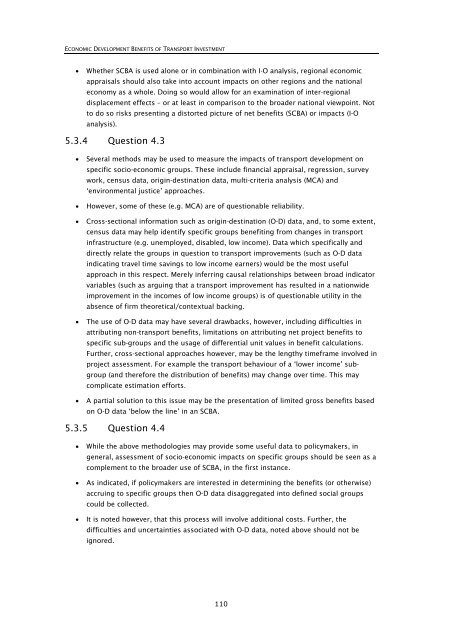Research 350 - NZ Transport Agency
Research 350 - NZ Transport Agency
Research 350 - NZ Transport Agency
Create successful ePaper yourself
Turn your PDF publications into a flip-book with our unique Google optimized e-Paper software.
ECONOMIC DEVELOPMENT BENEFITS OF TRANSPORT INVESTMENT<br />
• Whether SCBA is used alone or in combination with I-O analysis, regional economic<br />
appraisals should also take into account impacts on other regions and the national<br />
economy as a whole. Doing so would allow for an examination of inter-regional<br />
displacement effects – or at least in comparison to the broader national viewpoint. Not<br />
to do so risks presenting a distorted picture of net benefits (SCBA) or impacts (I-O<br />
analysis).<br />
5.3.4 Question 4.3<br />
• Several methods may be used to measure the impacts of transport development on<br />
specific socio-economic groups. These include financial appraisal, regression, survey<br />
work, census data, origin-destination data, multi-criteria analysis (MCA) and<br />
‘environmental justice’ approaches.<br />
• However, some of these (e.g. MCA) are of questionable reliability.<br />
• Cross-sectional information such as origin-destination (O-D) data, and, to some extent,<br />
census data may help identify specific groups benefiting from changes in transport<br />
infrastructure (e.g. unemployed, disabled, low income). Data which specifically and<br />
directly relate the groups in question to transport improvements (such as O-D data<br />
indicating travel time savings to low income earners) would be the most useful<br />
approach in this respect. Merely inferring causal relationships between broad indicator<br />
variables (such as arguing that a transport improvement has resulted in a nationwide<br />
improvement in the incomes of low income groups) is of questionable utility in the<br />
absence of firm theoretical/contextual backing.<br />
• The use of O-D data may have several drawbacks, however, including difficulties in<br />
attributing non-transport benefits, limitations on attributing net project benefits to<br />
specific sub-groups and the usage of differential unit values in benefit calculations.<br />
Further, cross-sectional approaches however, may be the lengthy timeframe involved in<br />
project assessment. For example the transport behaviour of a ‘lower income’ subgroup<br />
(and therefore the distribution of benefits) may change over time. This may<br />
complicate estimation efforts.<br />
• A partial solution to this issue may be the presentation of limited gross benefits based<br />
on O-D data ‘below the line’ in an SCBA.<br />
5.3.5 Question 4.4<br />
• While the above methodologies may provide some useful data to policymakers, in<br />
general, assessment of socio-economic impacts on specific groups should be seen as a<br />
complement to the broader use of SCBA, in the first instance.<br />
• As indicated, if policymakers are interested in determining the benefits (or otherwise)<br />
accruing to specific groups then O-D data disaggregated into defined social groups<br />
could be collected.<br />
• It is noted however, that this process will involve additional costs. Further, the<br />
difficulties and uncertainties associated with O-D data, noted above should not be<br />
ignored.<br />
110
















